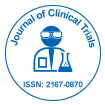
Journal of Clinical Trials
Open Access
ISSN: 2167-0870

ISSN: 2167-0870
Commentary - (2020)Volume 10, Issue 2
Should psychiatric symptoms start to be treated with bacteria? The manuscript on the first randomized placebo-controlled trial determining the effects of supplementation with synbiotics on reducing impulsive and compulsive behavior in a sample of patients diagnosed with attention deficit and hyperactivity disorder (ADHD) and/or borderline personality disorder (BDP) raises the question of a central implication of the brain-immunegut axis on, at least, a subgroup of mental disorders. Furthermore, it points into the necessity of designing new evidence-based therapeutic approaches for the management of still difficult-to-treat symptoms as for example, impulsivity.
Although sparse, recent evidence has suggested an association between immune imbalances and several psychiatric disorders, such as ADHDT [1-3]. However, studies searching for immunological markers in subjects with ADHD have not provided conclusive findings, likely due to small sample sizes and a high heterogeneity among the biological markers searched for. An increasing number of studies have shown a strong association between immune/allergic disorders (e.g. psoriasis, type 1 diabetes, asthma, and inflammatory bowel disease) and the risk of developing ADHD [4-6]. Interestingly, all the abovementioned disorders share a common immune background, i.e. an imbalance in the Th17/Treg axis [7,8]. T helper (Th)17 cells play a role in defense against bacteria, but also on autoimmunity and on allergic diseases [9-11], with an increase in these cells predisposing to autoimmunity or allergy [12,13]. On the contrary, T regulatory (Treg) cells maintain tolerance to selfantigens and prevent from autoimmune diseases. Importantly, increasing evidence suggests that not only microglia, but also T cell activity (and especially Th17 and Treg cells activity), might be needed for a proper brain development and function of important brain areas playing a role in mood, behavior and cognition, such as the hippocampus [14].
Recent reports have reported a regulatory action of the gut microbiota on the Th17/Treg axis by (among other factors), the production of serotonin, dopamine and/or noradrenaline precursors [15]. Thus, gut dysbiosis has not only been related to inflammatory conditions such as inflammatory bowel disease, but also, to neuropsychiatric conditions such as ADHD [16] Furthermore, recent studies have shown that, many agents used for the treatment of ADHD such as desipramine and/or bupropion [17,18]) might exert their action by correcting immune imbalances (such as Th17/Treg axis abnormalities). In addition, recent findings suggest immunomodulatory and antiinflammatory properties of probiotics [19], possibly by selectively targeting Th 17 cell lineages [20].
To sum up, although evidence supports the implication of the brain-immune-gut axis in mental disorders, the studies conducted so far have not identified which factors may play a causal role. More studies addressing how the microbiota interacts with the immune system and the brain are urgently needed to address this issue with important diagnostic and therapeutic implications.
The project under which the study is being performed is sponsored by the European Commission and funded by the European Union ’ s Horizon 2020 research and innovation program under grant agreement no. 728018. The sponsors and funders played no part in study design; collection, management, analysis, and interpretation of the data; writing of the report; or the decision to submit the report for publication.
Citation: Arteaga-Henríquez G, Ramos-Quiroga JA (2020) Commentary on Treating Impulsivity with Probiotics in Adults (PROBIA): Study Protocol of a Multicenter, Double-blind, Randomized, Placebo-Controlled Trial. J Clin Trials 10:406. doi: 10.35248/2167-0870.20.10.406
Received: 03-Mar-2020 Accepted: 17-Mar-2020 Published: 24-Mar-2020 , DOI: 10.35248/2167-0870.20.10.406
Copyright: √ā¬© 2020 Arteaga-Henr√ɬ≠quez G, et al. This is an open-access article distributed under the terms of the Creative Commons Attribution License, which permits unrestricted use, distribution, and reproduction in any medium, provided the original author and source are credited.